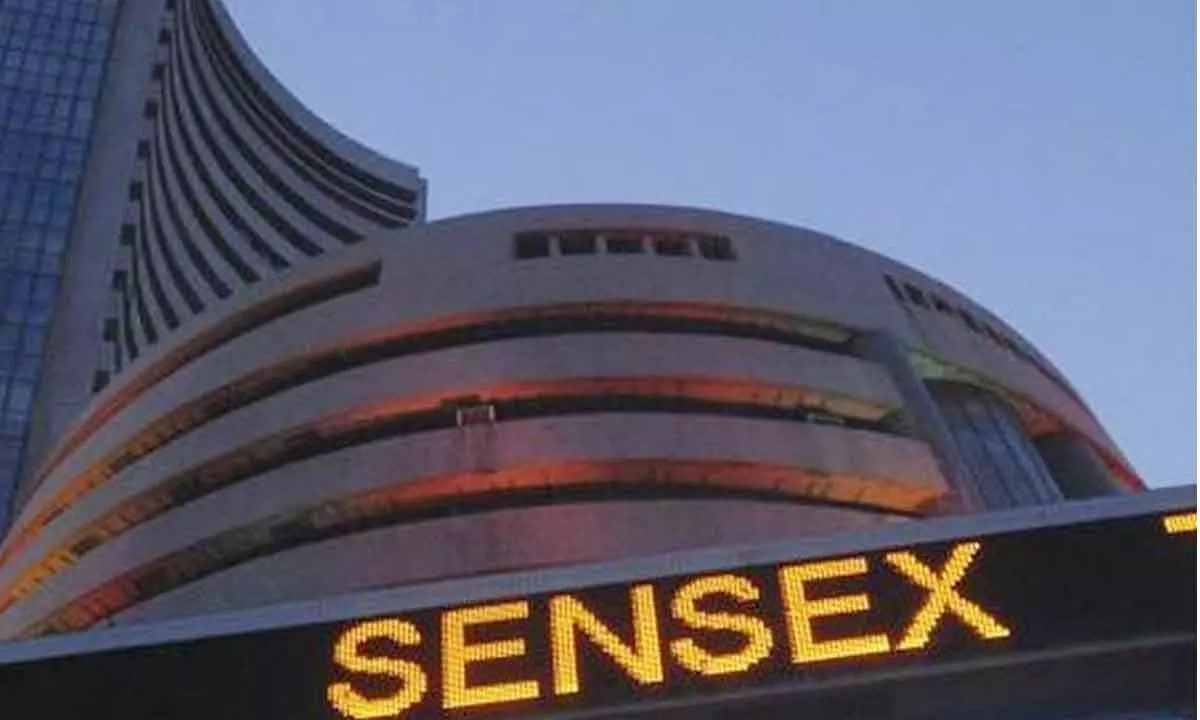Further pressure on markets likely amid volatility

BSE Sensex
Focus on stock-specific trading and avoid creating any fresh position unless there’s any positive data build up
Unnerved by hawkish stance of the US Fed, rupee hitting record low, renewed selling from FIIs and escalation in Russia-Ukraine conflict; the domestic stock market lost another one percent for the second consecutive week during the last week. BSE Sensex slipped 741.87 points or 1.26 percent to close at 58,098.92, while NSE Nifty fell 203.55 points or 1.16 percent to end at 17,327.30 level. Following the benchmark indices, the BSE Mid-cap and Small-cap indices fell one per cent and 1.3 per cent respectively. FIIs sold equities worth of Rs4,361.77 crore in the week gone by. On the other hand, DIIs bought equities worth of Rs1,137.96 crore. In September till date, FIIs have sold equities worth of Rs2,445.82 crore, and DIIs sold equities worth of Rs1,868.54 crore. Volumes were on lower side in the past few sessions. All sectoral indices ended in the red, with Realty, Power, Banks, Capital Goods and Telecom being the laggards. The advance decline ratio ended stood at 0.24:1. India equities so far have remained insulated from the higher inflation and slower growth worries, and have materially outperformed global peers, with the MSCI India delivering total returns of +3.3% on a year-to-date (YTD) basis compared to the MSCI World and the MSCI Asia ex Japan total returns of -19.7% and -21.4%, respectively.
Indian rupee touched a fresh record low (81.24) by crossing the 81 mark for the first time. Observers say it is possible the rupee could go to lower levels if policy rates do not increase as per the expectations. The US dollar is going strong. There have been FPI outflows and that there is demand for dollars from importers. Focus on stock specific action and avoid creating any fresh position unless there is any positive data build up in the market.
Listening Post: Investing in quality stocks seems like a smart move—but the bet on the blue chips hasn't paid off lately. It may have come as a shock to many investors that quality hasn't been performing defensively. Quality companies typically earn more of their profits farther into the future than cheap 'value' firms do—making their earnings less valuable in a time of rising inflation and interest rates. Part of the problem is that quality is in the eye of the beholder. Among the various factors that can contribute to returns—a company's market capitalization, how expensive the stock is, its recent price behaviour and so on—"quality is probably one of the most vaguely defined. Quality seems like a good feature to have in a company—but not quality at any price. Focus on companies' profitability—their operating profit, divided by net worth. That approach has lost less money than the overall market this year. Also toss in steady earnings growth, high cash flow, low debt or the rate of change in net operating assets, among various measures. Still others aim to own companies with strong 'moats,' meaning that they seem likely to be able to outcompete their rivals for years to come. By the beginning of this year, many investors held larger than average positions in technology. After all, it is among the industries that had shone brightest on these measures over the past few years. Unfortunately, they also were expensive. A lot of these great companies are so well-run, efficient and profitable that everyone wants to own them, so they tend to trade at premium valuations. In a falling market, the easiest and least painful way for investors to raise cash is to sell off their biggest winners first. That's contributed to a wave of selling in some of the top-performing technology stocks and highest quality—stocks of the past few years. Over the past three decades, quality stocks have outperformed about 80 per cent of the time when economic conditions were deteriorating. So, investors may have come to regard quality stocks as a panacea against bad markets—bidding them up to prices that weren't sustainable. Even after their recent pounding, quality stocks are still more expensive, relative to the market as a whole, than they've been 90 per cent of the time since 2000. Along with value, momentum, low volatility and several other characteristics, quality is one of the factors that investment researchers say have generated higher performance than the market as a whole in the past. Before long, investors will be complaining that quality is overrated and that other investing styles work better.
"Mark my words: At that point you will be able to get quality in quantity." That point is finally getting closer, but we're not there yet.
Quote of the week: "I don't look to jump over seven-foot bars; I look around for one-foot bars that I can step over." — Warren Buffett
Investors often make things too hard for themselves. The value stocks that Buffett prefers frequently outperform the market, making success easier. Supposedly sophisticated strategies, such as short selling, lose money in the long-run, so profiting is much more difficult.
F&O / SECTOR WATCH
Ahead of the settlement week, triggered by global cues, renewed shorts were seen in the derivative segment. However, volumes were a tad lower. On the option front, Call writers remained active at 17500-17600 & 17700 strikes, whereas Put writing was observed at 17,000 strike. After sustained display of strength for several weeks, the Bank Nifty slipped and closed below 40000 psychological level. Call writers turned active at 40000 Call strike whereas Put writers added marginal position in 39500 and 39000 strikes.
Implied Volatility (IV) of Calls closed at 17.57 per cent, while that for Put options, it closed at 18.97 per cent. The Nifty VIX for the week closed at 18.82 per cent. PCR of OI for the week closed at 0.92. On downside, the 17,000 level would act as support for Nifty, while 17500-17600 zone is likely to offer strong resistance. Instead of getting rid of existing Buy positions out of fear and / or restraining yourself from selling after the fall, use Put options and trade at every opportunity presented to you without hesitation. With as many as close to 10 countries hiking interest rates in the past two days (21st and 22nd), which include USA, England, Switzerland, Taiwan, Hong Kong, Norway, Saudi Arabia and UAE, among others; observers expect the RBI to toe the US Fed's line and remain hawkish. However, the quantum of rate hike would be lower at 50 bps compared to Fed's 75 bps so as to not disrupt the economic growth. The six-member Monetary Policy Committee is scheduled to meet from September 28-30. Expect Banking & Financials to trend lower till the RBI decision. Follow the basics, avoid highly-leveraged positions and overall exposures should be limited. A short-covering rally from the lower levels cannot be ruled out. A cautious view is advised for the coming week. Stock futures looking good are CUB, ITC, Jubilant Food, L&T, RBL Bank, Marico, Rain Inds and Sun Pharma. Stock futures looking weak are ABB, BPCL, Bandhan Bank, Coal India, IOC, Oberoi Realty and UPL.














